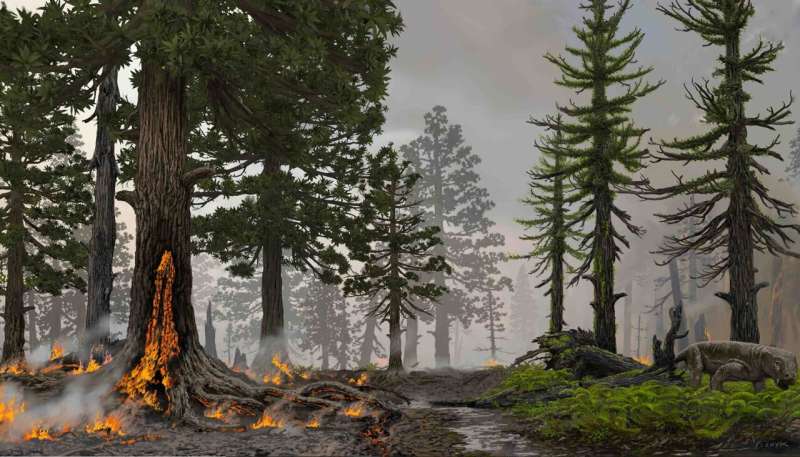During the worst mass extinction event in Earth’s history, vast wetlands faced increasing wildfires, turning the world’s largest carbon sinks into carbon sources. Credit: Victor O. Leshyk
Researchers from University College Cork (UCC) and the Swedish Museum of Natural History investigated the late Permian mass extinction (252 million years ago) that wiped out nearly every species on Earth, causing entire ecosystems to collapse. The researchers discovered a sharp spike in the wildfire activity of this most devastating mass extinction. Promoted by the rapid release of greenhouse gases from volcanoes, extreme warming and desiccation led to wildfires in vast areas previously permanently wet. Rather than trapping carbon from the atmosphere, these wetlands became major sources of atmospheric carbon, reinforcing the strong warming trend. The research was published in Palaios Today.
Fossils explored in Eastern Australia and Antarctica
By studying fossil plant and charcoal records from the Sydney & Bowen basins in eastern Australia and Antarctica (Lambert Graben), the researchers found that the wetlands were regularly disturbed by fires leading to extinction. In response, the plants had developed a series of fire-resistant mechanisms. However, severe climate change and the spike in fire activity during extinction seem to have pushed even these fire-adapted plants over a tipping point from which the entire ecosystem could not recover for millions of years.
“During the search of the fossil plant records of Eastern Australia and Antarctica, we found large amounts of burnt or charred plants during the late Permian period. From this high baseline, the charcoal abundances reached a prominent peak right at the apex of the latter Permian. -coal This points to a large but short-lived increase in forest fires, which was followed by low charcoal during the next three million years of the Early Triassic, burnout at the end of the Permian, followed by a depression in the Early Triassic,” says Dr. Chris. Mays, a paleontology lecturer at University College Cork (UCC) and lead author of the study.
Earth heading for a similar mass extinction?
The researchers emphasize that in today’s world, wildfires have led to shocking mass deaths of animals in several regions around the world (e.g. California 2018, 2020, Australia 2019-20). At the same time, our warming global climate has led to prolonged droughts and increased wildfires in typically wet habitats, such as Indonesia’s peat forests and the vast Pantanal wetlands of South America. These large ‘carbon sinks’ (regions of natural uptake of carbon from the atmosphere) are crucial in our fight against climate change. As the fossil record reveals, without these areas of carbon capture, the world could remain unbearably warm for hundreds of millennia.
“The potential for wildfires to act as a direct driver of extinction during hyperthermic events, rather than a symptom of climate change, deserves further investigation and help prevent the worst effects of modern warming,” said Dr. Mays.
Mysterious Climate Behavior During Earth’s Most Severe Mass Extinction Explained
CHRIS MAYS et al, End-Perm Burnout: The Role Of Perm-Triassic Wildfires In Extinction, Carbon Cycling, and Environmental Change in Eastern Gondwana, Palaios (2022). DOI: 10.2110/palo.2021.051
Quote: Wildfires may have led to ecosystem collapse during Earth’s worst mass extinction (2022, June 30) recovered June 30, 2022 from https://phys.org/news/2022-06-wildfires-ecosystem-collapse -earth-worst.html
This document is copyrighted. Other than fair dealing for personal study or research, nothing may be reproduced without written permission. The content is provided for informational purposes only.

